| Menko | Batomen | Pogs | Tazos | Staks |
Menko
Menko are one of the more common items I see that come with either little or no information. I'm tired of that, so it's time to go on a deep-dive!
Menko (also known as Bettan and Patchin) being a card game involving 2 or more players, dating back several hundreds of years in one form or another. Players have rectangular cards or circular chips, which are also known as menko, so you use menko to play menko!
In most forms, Menko operates like a game of Pogs where the goal is to flip over the opponents' menko, and the player with the most flips is the winner. Variations of play exist, detailed below, and it's since become an easy way to cheaply merchandize anime, manga, and games.
 (courtesy of divajoanne) |
Ways of Playing Menko
No. 1) Flip your opponents' menko over and you win. No. 2) Bump your opponents' menko across the line/out of bounds and you win. No. 3) Make a pile by stacking several menko. Knock your opponents' menko off and upside down and claim it as your own. Get the most and you win. |
Numerous companies have made menko for the Pokémon franchise with Tomy leading the fray. Most of the menko I've seen for Pokémon are in a chip form of varying sizes, the largest that I know of being Amada's Hyper Menko set (1998).
For online listings, the term "menko" is often used for any cardboard chip or card, including those not meant for Menko, such as board game pieces. Just because it's called a menko doesn't mean it's technically a menko, but pedantics can only take you so far.
Batomen
Batomen is an acronym for "Battle Menko."
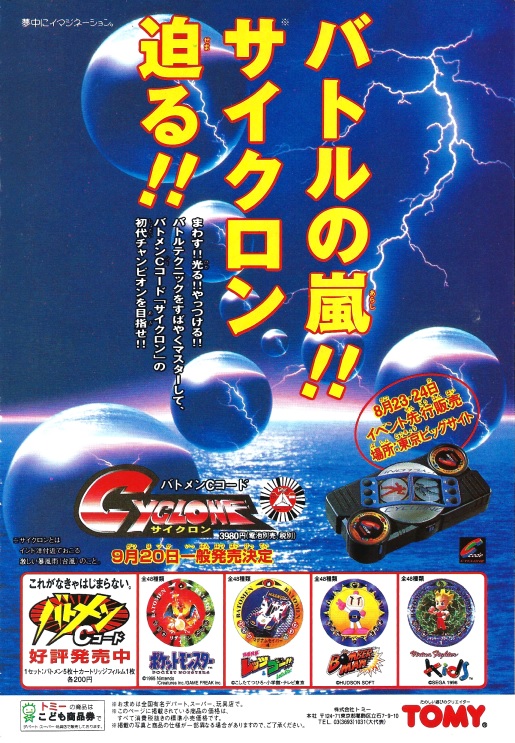
Battle menko (or Batomen for short) are a logical extension of this game, utilizing laminated cardboard chips with a circular barcode on the back. With sets focused on innumerable franchises and sports (racecar sets seem to be quite common), these were meant to be collected and used with the Cyclone, a battery-operated handheld device released by Tomy on August 23, 1996. By inserting a Batomen into a round slot on the Cyclone and then used to battle other players by manually spinning (clockwise and counter-clockwise rotation offer different effects). Of course, your opponent needed their own Cyclone to connect with yours via an aux cable.
Tomy would release an updated follow-up under the name Super Batomen 2 in 1999, which added a single player mode and updated screen. The toy would also be given a USA Pokémon-specific release that same year under the name Cyclone 2. The American release came packaged with 8 starting chips: Caterpie, Charmander, Kabuto, Lickitung, Onix, Spearow, Tentacool, and Weedle.
Batomen chips could be obtained through a variety of means, with booster packs or through magazine extras. Booster packs of 5 Batomen would sell for 200 yen each. CoroCoro Comics would use the latter method to drum up interest, including cardboard sheets of 5 special Batomen chips (e.g. the original chips for Mewtwo and Mew were released in this way) in the magazine for the reader to punch out and then use.
This is also the source of one of the listing quirks I frequently see: the inclusion of "C Code" as a keyword. This isn't actually much of a mystery, however, as "C Code" is just a term blanket-applied to Batomen ads as a marketing ploy to make them look cool to kids (the C stands for Cyclone). So now many store sites will over-use the term for SEO purposes.
Another listing quirk is that many listings have Batomen as being released in 1995, based off the copyright on the back. This is incorrect, as the first set of Pokémon-themed Batomen chips were first announced in the July 1996 issue of CoroCoro Comics magazine and given a release date of September 20, 1996.
As far as I can find, there were 4 total Pokémon Batomen sets released:
| September 20, 1996 |
The first set is released. The front is marked by a half-red, half-green outer circle. The back is yellow.
A late 1996 CoroCoro Comics magazine came with a cardboard sheet that included a holographic Mewtwo and Mew which came with a purple back. |

|

|
|
|
|||
| Early 1997 | The second set is released. Distinct in using the same watercolor art as the first set, but in conjunction with a solid yellow-ish colored outer circle. The back is the same shade of yellow as set 1. | ||
|
|
|||
| Late 1997 |
The third set, released in 2 parts: Pokémon Anime Version Part 1 and Pokémon Anime Version Part 2. Distinct in using the standard anime character art with a variable solid-colored outer circle based off the chip typing (blue for water, green for plant, yellow for electric, and red for fire). The back is the same yellow as the prior two sets.
Part 2 would include the multiple lines of "Pocket Monsters" overlayed on the front's background. |

|
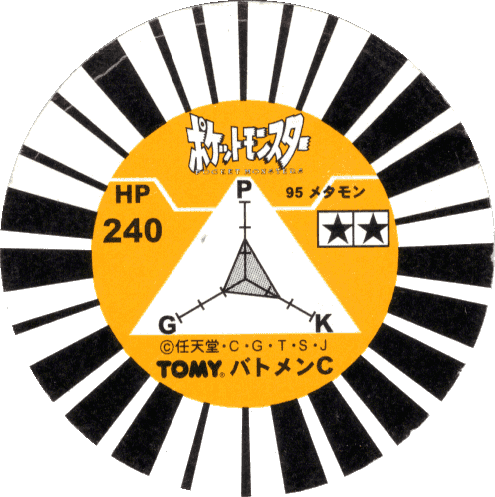
|
|
|
|||
| 1999 |
The multi-release in conjunction with the new Cyclone 2 consisting of the following sets: Pokémon Red Batomen, Pokémon Green Batomen, and Pokémon Yellow Batomen. The fronts return to the standard watercolor art. The back is green.
This set was translated and brought over for the American release of the Cyclone 2. |
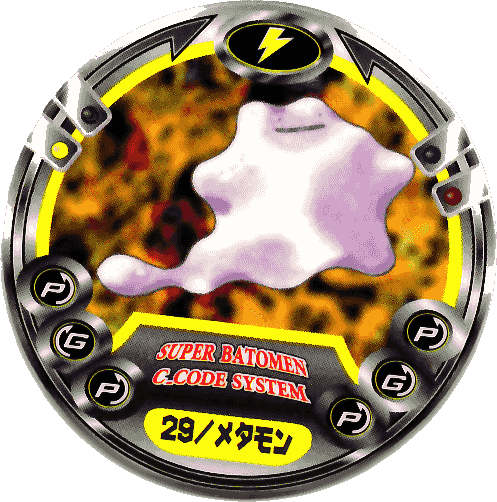
|
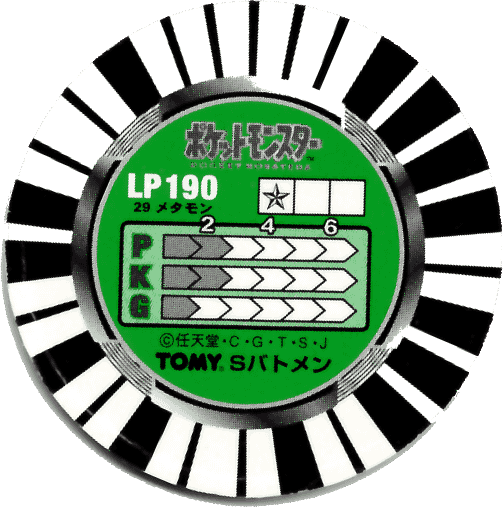
|
The specifics of how to play Batomen is a bit obtuse, but I'll try my best to explain.
The Batomen chipswere two-sided: the front having character art, a Typing (does not match Pokémon typing!), and 1 or 2 Mortal Technique commands (a set of 3 circles on both the left and right side with a combination of "G", "K", and "P" and symbols indicating clockwise or counter-clockwise motions), while the back has a circular barcode and the attribute data (containing a scale for "G", "K", and "P" as well as a star ranking and HP for the Japanese chips/LP for the English).
G stands for Guarding Power, K for Kicking Power, and P stands for Punching Power. You'll notice that these terms aren't exactly relevant to Pokémon, quirks of the Batomen system. HP is Health Points, while LP is Life Points. I've not figured out the star rankings, yet. They might be related to Item usage?

For Pokémon, the stats for the initially released set are... hard for me to grasp the meaning of? Ditto's Batomen has low but well-rounded G, K, and P values; it's HP is 190 and it gets a 2-star ranking. In comparison Mewtwo has a much lower HP (175) with slightly lower G, K, and P and only a 1-star ranking. Odd... Charizard, Poliwhirl, and Rhydon share the highest HP I could find (225), while Farfetch'd has the lowest (120), which is much lower than Caterpie's HP (165)... I just don't fully understand how each Pokémon got what numbers attached to them...
In any case, whether you're playing single or otherwise, you insert your Pokémon Batomen and have a turn-based battle (A diagram of the Cyclone 2's screen is on the left). Each turn is forcible short to encourage a fast gameplay style, only a few seconds in length, during which you spin your Batomen with a finger, trying to use P or K to overcome your opponent's G. You can use a Mortal Technique by spinning the Batomen and pressing the requisite buttons on the device for added damage. By breaking the defense wall, you can chip away at your opponent's HP. The first to 0 loses.
There's definitely more nuance, with Vantage Marks, Item marks, and Life stones, but that's the general gist.
Pogs
Pogs are (more or less) Western-made menko. More commonly known as "Milk Caps" ("Pogs" is the commercialized version), the game is played the same way, with similar shaped chips.
It's thought that Pogs date back to the 1920s in Hawaii, possibly as a form of Menko brought over by Japanese immigrants. In the 1950s, companies such as Haleakala Dairy began including special pop-out caps in their packaging as promotional items. In 1971, Haleakala Dairy used the caps to promote their new passionfruit, orange, and guava blend juice (the acronym Pog being used as the product name, which is where "Pogs" got its name in the 1990s). The game made it's way from Hawaii to the mainland in the early 90's and proved a big hit.
Now get ready for a fun fact... As far as I can tell, for as common as the word "Pogs" is on online listings... There are no Pogs for the Pokémon franchise. There's Tazos, but no official Pogs, which are made by the sole owner of the trademark: World POG Federation. I found one set of "Pogs" that didn't have the Tazos brand on them, but they were also listed as "Chips Tazos Pogs" so I'm pretty hesitant to label them Pogs.
Tazos
Tazos are legally-distinct Pogs, created solely for use by the potato chip company Frito-Lay.
Starting in 1994 Frito-Lay added chip sets for Looney Tunes and Tiny Toons to products made by their Mexican subsidiary Sabritas, and got its name from the expression taconazo ("kick with the heel"), after a schoolyard game in which kids tried to launch bottle caps from closed bottles with a well-aimed kick. It quickly spread as a popular snack food extra.
Pokémon would get several sets of Tazos, some metallic, others with lenticular images, with various countries getting varying but simultaneously-released sets. Given the far-reaching spread of Tazos, it's nigh-impossible to create a fully comprehensive list of all the sets, but we can try!
| Pokémon | (1999) | Set of 51 chips, sometimes designated "Series 1 Set 1," mostly various Pokémon and one for Ash |
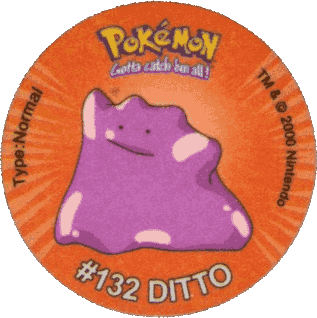
|
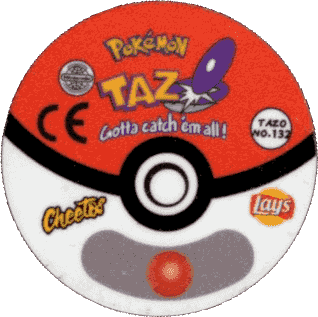
|
|
|
||||
| Pokémon 2 | (2000) | Set of 100 chips, sometimes designated "Series 1 Set 2," as it completes Gen 1 | ||
|
|
||||
| Pokémon Masters | This set was of the human characters | |||
|
|
||||
| Pokémon 3 | (2001) | |||
|
|
||||
| Pokémon Trio | (2001) | Set of triangle-shaped lenticular chips of Gen 1 and 2 Pokémon, and some human characters | ||
|
|
||||
| Pokémon Zapper 1 & 2 | Set of 20 chips (10 each) | |||
|
|
||||
| Pokémon Flash | Set of 33 chips | |||
|
|
||||
| Pokémon Duo | Set of 40 chips, Mostly Gen 2, including Misty, Ash, Brock, and Gary | |||
|
|
||||
| Pokémon Nox | (2005) | Set of chips with 4 edged corners on the bottom and arounded top edge, encased in protective plastic | ||
|
|
||||
| Pokémon Trio | Set of 10 3D lenticular chips of Gen 1 and 2 Pokémon, one chip per evolutionary line | |||
|
|
||||
| Pokémon Gold / Pokémon Metallix | (2007) | This set was made with metal, hence it's second (country-dependent) name | ||
|
|
||||
| Pokémon Metal: Attack | Set of 50 metallic chips for Gen 3 | |||
|
|
||||
| Pokémon 4: Advanced Generation | (2008) | Set of 235 chips | ||
|
|
||||
| Pokémon Rock | Set of 40 chips, Gen 4, had a ribbed plastic edging to protect the cardboard | |||
But how was Tazos played? There's a lot of variants, with the most common being each player sets up an face-down Tazos in equally-sized stacks. They then take turns attacking the other player's stack, often with a zapper Tazos. Any Tazos knocked down face-up is taken. Pokémon Tazos were unique, however, in that each one has assigned types and weaknesses, which can also factor it. Human characters are considered strong against all types.
For a much more in depth look at sets, please check out the Tazos articles on Pokepolis!
Staks
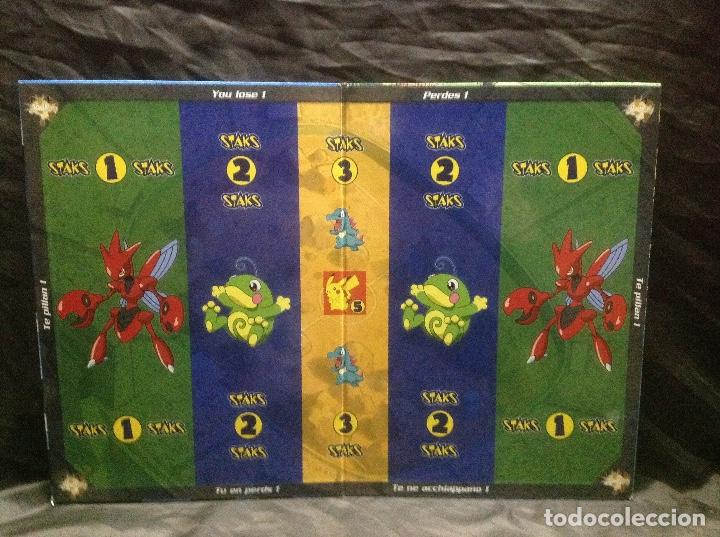
Staks were Pogs, but magnetized! Released in at least 3 sets by Portuguese company Panini: Pokémon Johto League Champions (2002) with 260 magnets, Pokémon Advanced (2006) with 210 magnets, and Pokémon Go (2016) with 238 magnets.
The game used a magnetized board, divided into 5 betting zones. Players take turns place bets (using their own Staks) on where on the board the Staks will land and then throw them onto the board. If a player hits their betted zone, they receive the other player's Staks; if they do not, then they receive nothing and the round continues. If the player lands on the edge of the board (or misses it completely), they must then give one Staks to every other player.
The Advanced set would also get released in the US and Germany. There were Staks binders made, to allow for safekeeping, if you didn't want to put them on your fridge. Of the various Menko and Menko-adjacent games, I find this one the most interesting!